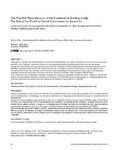The Post-War Reconstruction of the Ecclesiastical Building in Italy. The Role of the Pontifical Central Commission for Sacred Art

Ver/Abrir
Use este enlace para citar
http://hdl.handle.net/2183/25371
Excepto si se señala otra cosa, la licencia del ítem se describe como Atribución-NoComercial 4.0 España
Colecciones
Metadatos
Mostrar el registro completo del ítemTítulo
The Post-War Reconstruction of the Ecclesiastical Building in Italy. The Role of the Pontifical Central Commission for Sacred ArtTítulo(s) alternativo(s)
La reconstrucción de la posguerra del edificio eclesiástico en Italia: el papel de la Comisión Central Pontificia para el Arte SacroAutor(es)
Fecha
2020Cita bibliográfica
Pirro, Michela. 2019. «La reconstrucción De La Posguerra Del Edificio eclesiástico En Italia». Actas De Arquitectura Religiosa Contemporánea 6 (diciembre), 50-67. https://doi.org/10.17979/aarc.2019.6.0.6227
Resumen
[Resumen] Aunque consideramos que el Concilio Vaticano II es el destino final de un camino de renovación para la historia del arte
sacro contemporáneo, sin embargo, es necesario centrarse en su fase preparatoria durante los años de reconstrucción de
la posguerra.
Aunque el primer impulso a este proceso se dio con la institución de la Comisión Central Pontificia para el Arte Sacro
(CCPAS), muy deseada por Pío XI, cuyo propósito era mantener «un sentido del arte cristiano», la figura clave para la formación
de los artistas primero, y luego por la compleja tarea de dirigir las obras de reconstrucción de todos los edificios
eclesiásticos devastados por la furia de la guerra, fue Mons. Giovanni Costantini, tercer presidente de CCPAS.
Esta contribución tiene como objetivo resaltar, a través de una lectura comparativa de fuentes de archivo inéditas, relacionadas
con la región de Abruzzo, y literatura consolidada, cuáles fueron los dictados de CCPAS con respecto a las intervenciones
en edificios existentes y cómo influyeron en los resultados que surgieron durante el primer período de reconstrucción
(1945-56). [Abstract] Although we consider the Second Vatican Council the final destination of a path of renewal for the history of contemporary
sacred art, it is, however, necessary to focus on its preparatory phase during the years of post-war reconstruction.
Though the first impulse to this process was given with the institution of the Pontifical Central Commission for Sacred Art
(PCCSA), strongly desired by Pius XI, whose purpose was to maintain «a sense of Christian art», the key figure for the
formation of the artists first, and then for the complex task of directing the reconstruction works of all the ecclesiastical
buildings devastated by the fury of the war, was Msgr. Giovanni Costantini, third president of the PCCSA.
This contribution aims to highlight, through a comparative reading of unpublished archival sources, relating to the Abruzzo
region, and consolidated literature, what were the dictates of the PCCSA regarding interventions on existing buildings and
how they influenced the results that arose during the first period of reconstruction (1945-56).
Palabras clave
Pontifical Central Commission for Sacred Art
Reconstruction
Ecclesiastical heritage
Abruzzo dioceses
Italy
Comisión Central Pontificia de Arte Sacro
Reconstrucción
Patrimonio eclesiástico
Diócesis de Abruzzo
Italia
Reconstruction
Ecclesiastical heritage
Abruzzo dioceses
Italy
Comisión Central Pontificia de Arte Sacro
Reconstrucción
Patrimonio eclesiástico
Diócesis de Abruzzo
Italia
Versión del editor
Derechos
Atribución-NoComercial 4.0 España
ISSN
2340-5503






